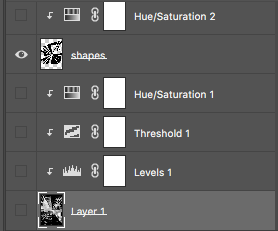- Open an image on photoshop
- Add threshold adjustment layer
- Add hue and saturation layer (visualise the ink we will print with)
- turning off the hue/saturation layer will allow to see the positives of the print

- One way that the layers can be manipulated would be to use the wand tool to select a shape to bring forward over another layer.
- In order to print an image it first needs to be changed to halftone.
- Frequency - the number of lines per inch (the spacing of the halftone dots) 50 lines per inch is the highest printable frequency.
- Angle - 15 degrees per ink to avoid moire patterns (optical interference)
- Use black and white laser printers to create the positives ( up to size A3)
- Make sure the image is in greyscale mode first in photoshop. Then switch to illustrator to print the positive.
- Create 'New' doc in illustrator and 'place' the halftone image on the art board. Then choose file > print to send to a printer, in black and white.
- The frequency of the black can be changed when printing option is selected. Document Ink > Process Black > 50 LPI. Black should be the only colour selected for print.
- Creating a larger format image, requires the image to first be greyscale, then changed to Bitmap mode. This means it will be possible to change the size of the pixels per inch without losing quality (300 ppi > 1200 ppi). The file is best to be created as a tif file and has to be printed in a digital ink printer, not a laser printer.
Printing in CMYK
- Make sure the mode of the image is CMYK
- Next to the layers panel, the channels palette will show the cyan, magenta, yellow and black.
- Each channel is a positive that will allow to create CMYK of the print.
- Open illustrator and create 'New' doc. Then place the tif file onto the A4 or A3 art board.
- Printing the image will then mean looking at the 'Output > mode > Process Cyan, Process Magenta, Process Yellow, Process Black'.




No comments:
Post a Comment